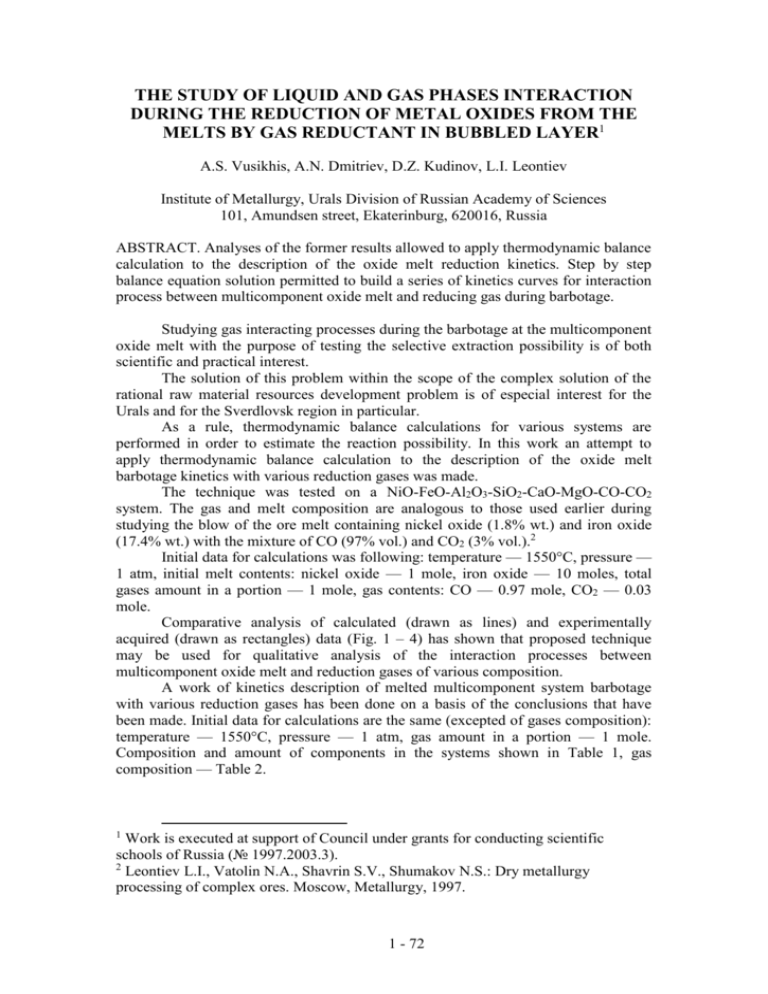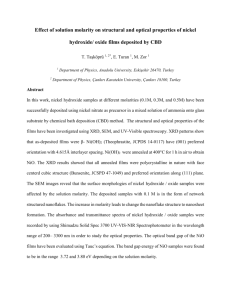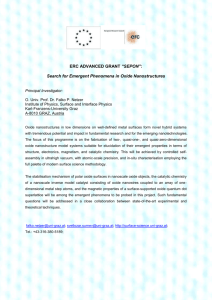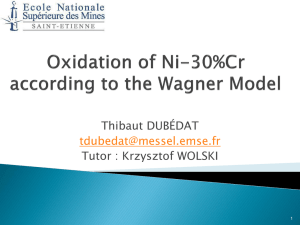Paper
advertisement

THE STUDY OF LIQUID AND GAS PHASES INTERACTION DURING THE REDUCTION OF METAL OXIDES FROM THE MELTS BY GAS REDUCTANT IN BUBBLED LAYER1 A.S. Vusikhis, A.N. Dmitriev, D.Z. Kudinov, L.I. Leontiev Institute of Metallurgy, Urals Division of Russian Academy of Sciences 101, Amundsen street, Ekaterinburg, 620016, Russia ABSTRACT. Analyses of the former results allowed to apply thermodynamic balance calculation to the description of the oxide melt reduction kinetics. Step by step balance equation solution permitted to build a series of kinetics curves for interaction process between multicomponent oxide melt and reducing gas during barbotage. Studying gas interacting processes during the barbotage at the multicomponent oxide melt with the purpose of testing the selective extraction possibility is of both scientific and practical interest. The solution of this problem within the scope of the complex solution of the rational raw material resources development problem is of especial interest for the Urals and for the Sverdlovsk region in particular. As a rule, thermodynamic balance calculations for various systems are performed in order to estimate the reaction possibility. In this work an attempt to apply thermodynamic balance calculation to the description of the oxide melt barbotage kinetics with various reduction gases was made. The technique was tested on a NiO-FeO-Al2O3-SiO2-CaO-MgO-CO-CO2 system. The gas and melt composition are analogous to those used earlier during studying the blow of the ore melt containing nickel oxide (1.8% wt.) and iron oxide (17.4% wt.) with the mixture of CO (97% vol.) and CO2 (3% vol.).2 Initial data for calculations was following: temperature — 1550°C, pressure — 1 atm, initial melt contents: nickel oxide — 1 mole, iron oxide — 10 moles, total gases amount in a portion — 1 mole, gas contents: CO — 0.97 mole, CO2 — 0.03 mole. Comparative analysis of calculated (drawn as lines) and experimentally acquired (drawn as rectangles) data (Fig. 1 – 4) has shown that proposed technique may be used for qualitative analysis of the interaction processes between multicomponent oxide melt and reduction gases of various composition. A work of kinetics description of melted multicomponent system barbotage with various reduction gases has been done on a basis of the conclusions that have been made. Initial data for calculations are the same (excepted of gases composition): temperature — 1550°C, pressure — 1 atm, gas amount in a portion — 1 mole. Composition and amount of components in the systems shown in Table 1, gas composition — Table 2. 1 Work is executed at support of Council under grants for conducting scientific schools of Russia (№ 1997.2003.3). 2 Leontiev L.I., Vatolin N.A., Shavrin S.V., Shumakov N.S.: Dry metallurgy processing of complex ores. Moscow, Metallurgy, 1997. 1 - 72 Fig. 1. Nickel contents in an alloy Fig. 2. Nickel oxide contents in the melt 1 - 73 Fig. 3. Nickel extraction into the alloy Fig. 4. Slag ratio Table 1. Oxide system composition and amount of components NiO FeO SiO2 Al2O3 CaO MgO Unit 1 10 40 3 10 2 Mole 0,015 0,152 0,606 0,045 0,152 0,03 Molefraction 1,8 17,4 58,0 7,4 13,5 1,9 % wt 1 - 74 Table 2. Initial gas composition in a bubble (portion), % vol. Version CO CO2 H2 H2O 1 100 0 2 97 3 3 95 5 4 92,5 7,5 5 87,5 12,5 6 80 20 7 75 25 8 0 0 100 0 9 33,1 0,01 66,3 0,6 10 30,9 2,4 55,8 10,9 11 26,3 6,9 40,4 26,4 Versions 1 through 7 are CO-CO2 mixtures with various amounts of components, version 8 is pure hydrogen, and versions 9 through 11 are results of rock gas oxygen conversion at different oxygen flow factors. Thermodynamic calculation results are represented at Fig. 5 – 8. Analysis of the results that have been got shows that a joint iron and nickel reduction process with reduction gases barbotage depends on their composition. During the reduction with pure gas (H2, CO or their mixture) one with the carbonic oxide is the slowest. Rising the amount of hydrogen speeds the process up; reduction with pure hydrogen is the most effective. During barbotage nickel reduction speed decreases, and irons one increases. During melt blowing with H2+CO mixture reduction process is performed basically with hydrogen, CO Influence is much less. Nickel extraction degree is great, but with barbotage duration increase iron extraction degree increases also, which can lead to significant ferrous alloy dilution. During the reduction with a gas mixture containing reaction products (CO2 and H2O) both oxides reduction degree decreases, their reduction speeds fall, and so do metal extraction degrees. Thus, depending on the chosen aim, reduction gas of various compositions may be used, which can be generated with various kinds of solid, liquid or gas fuel usage. The reduction with hydrogen is the most effective, but such gas generation leads to a great expenditure. Converted rock gas usage is much less expensive. Rock gas conversion may be accomplished with various oxidizers: oxygen, water vapor, and carbon dioxide. Depending on the oxidizer concentration converted gas will contain different CO, H2, CO2 and H2O amounts. As shown by calculations, gas made of CO and H2 with maximal hydrogen amount is the most effective. Gas of such composition may be generated with rock gas vapor conversion; oxygen conversion product contains 8% more CO, though energy expenditures for its generation are much less. 1 - 75 Fig. 5. Nickel contents in an alloy Fig. 6. Nickel oxide contents in the melt 1 - 76 Fig. 7. Nickel extraction into the alloy Fig. 8. Slag ratio 1 - 77









